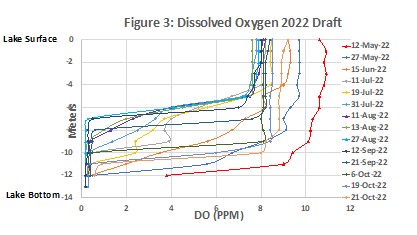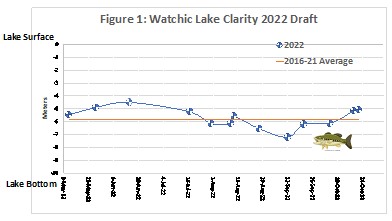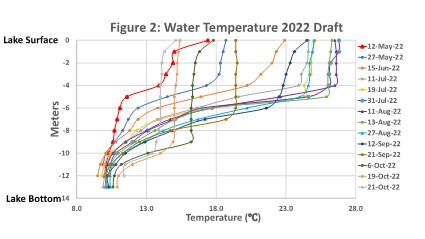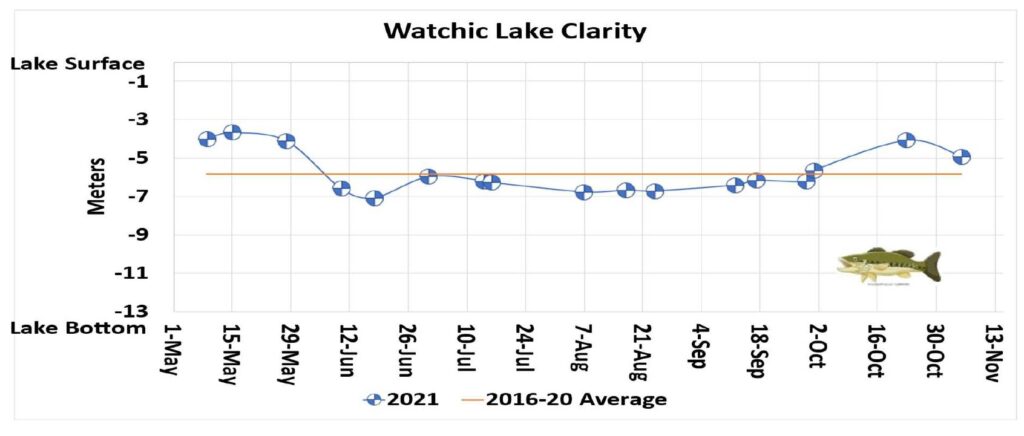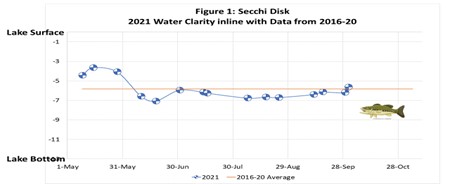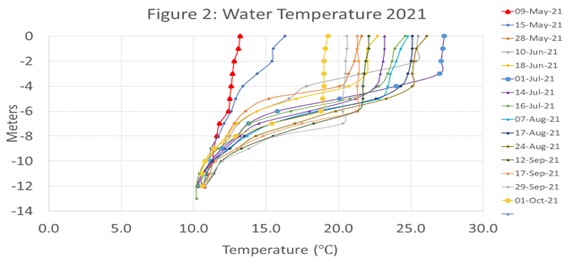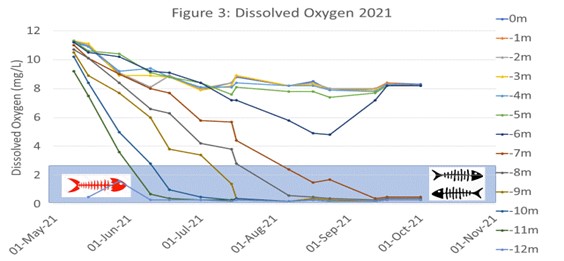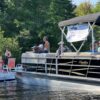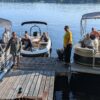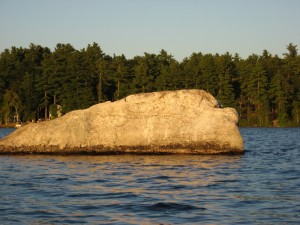
Big Rock, Watchic Lake
By most any measures, the quality of Watchic Lake is very good. A clean lake benefits everyone. Not only does it create excellent recreational opportunities, it also ensures a healthy environment for wildlife, and helps maintain shoreline property values.
One way to measure water quality is to use a Secchi Disk, which is an instrument that measures clarity. It is lowered into the water and the depth at which the disk can no longer be seen is recorded as a measurement of lake clarity. Secchi Disk readings are taken regularly at Watchic Lake and are in the 4 to 4.5 meter range (meaning transparency down to about 15 – 16 feet). For real-time Secchi disk readings during the summer, touch or click here for Maine VLMP Near Real Time Lake Data.
The Watchic Lake Association (WLA) is dedicated to monitoring and improving the quality of Watchic Lake. The Association does regular lake quality readings, manages the dam to ensure appropriate water levels, directs major remediation projects (such as the Paine Neighborhood project), coordinates the LakeSmart program, and works with property owners on an ad hoc basis to address quality issues.
It is up to all of us to protect this lake. While we own the property currently, we are but stewards for now; the future of the lake is in our hands.
- Please consult Standish Town Hall and/or the Department of Environmental Protection for information on any changes to your property.
- Expansion, tree removal, and drainage changes can adversely affect water quality and are all closely monitored.
- Landscaping products that were acceptable in an urban environment may create problems in a shore front location. Phosphorous from runoff is our worst enemy.
2023 Water Quality Update
2023 was a difficult year for the lake. Watchic continues to be under a lot of pressure from an increase in year-round homes, and other development around the lake, leading to the lake having the ominous distinction of being included in Maine’s threatened lakes.
The summer of 2023 was rainy with several rain events greater than one inch. June, July, and August averaged around six inches of rainfall. Historically, Watchic Lake has its worst years of water clarity when there is greater than normal rainfall. Using a Secchi disk and scope twice a month, the Watchic Lake volunteer monitors recorded lower water clarity readings than the 2016-2022 average. Many of the readings were in the 3-4 meter depths as opposed to an average around 5.5 meters. Going back to data since 1977, 2023 is a year that stands out with low Secchi disk readings. See chart below.
Many people noticed a change in the color of the water which was recorded as higher than normal. Due to high precipitation totals causing increased runoff, Total Phosphorus levels were some of the highest ever recorded on Watchic. High Total Phosphorus means trouble for lakes because it is food for more plant growth.
Along with increasing water temperatures, 2023 was the first year that Watchic experienced a visible Cyanobacteria bloom. We thank the property owners for reporting the presence of this neon green paint-like appearance of Cyanobacteria. Whereas New Hampshire issued 69 advisories for toxic Cyanobacteria on 44 lakes in 2023, Maine has fewer cases to date, but NH may be a good indicator of Maine’s future. Several Watchic samples were analyzed, and several types of Cyanobacteria were identified.
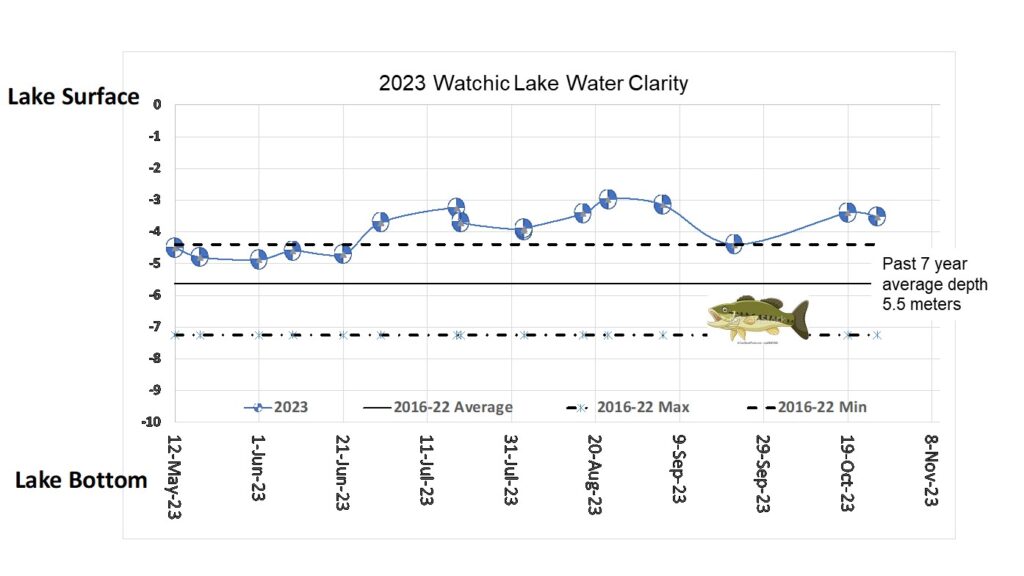
We can all help keep our lake clean and healthy! Please remain vigilant this year.
- Take action to reduce rain water runoff into the lake. Contact Stephanie Parker for best practices to avoid runoff.
- Note any changes in water color or large/unusual algal blooms by contacting David Burnell.
- Report strange plants to Stephanie Parker who will help evaluate the plants and address issues if needed.
2022 Water Quality – Full Year Report
By The Watchic Lake Water Quality Committee
Based on the findings contained in the full year report, the water quality of Watchic Lake remains good, and is not substantially changed from data collected over the previous 6 years (2016-2021), or
from data back to the 1970’s. Specifically, water clarity and total phosphorus levels are
consistent with previous years and consistent with other Maine lakes like ours. All data
reported here was collected by the Watchic Lake Water Quality Committee and represents over
70 hours of volunteer time.
The 2021/22 winter was the third in a row where the lake was frozen (ice covered) for less that
100 days. 2022 was a moderate year for rain (23.1 inches from April to October). Spring (May
and June) were dry this year (only 2.8 inches of rain combined) compared to the months of
April, and July – October each had 3.6-5.0 inches of rain. Despite these changing weather
patterns, lake quality as measured by trophic state indicators (water clarity and core total
phosphorus and chlorophyl-A levels) was similar to recent years. No major algae issues were
reported. We experience long periods of low dissolved oxygen levels at the bottom of the lake
again in 2022. At the 11m depth, the dissolved oxygen was below 1mg/L from May-Oct. Such
conditions can restrict fish populations and increase algae growth.
Please click or touch here for the full 2022 Water Quality Report.
2021 Full Year Water Quality Report
Based on the findings contained in the 2021 Watchic Lake Water Quality Report, the water quality of Watchic Lake remains good, and is substantially unchanged from data collected over the previous 5 years (2016-2020), and from data back to the 1970’s. Specifically, water clarity and total phosphorus levels are consistent with previous years and consistent with other Maine lakes like ours. All data reported here was collected by the Watchic Lake Water Quality committee and represents over 70 hours of volunteer time with a budget of ~$1500 for lab work and testing equipment (3-5 year life).
2020/21 winter resulted in a short period when the lake was frozen (86 days) and had a long ice-free/algae growing period (268 days). In 2021, we experienced a very dry June (0.6 inches of rain) and very wet July (8.7 inches). Despite these extremes, lake quality as measured by trophic state indicators (water clarity and core total phosphorus and chlorophyl-A levels) was similar to recent years. Consistent to previous years, we experience long periods of low dissolved oxygen levels at the bottom of the lake in 2021. At the 11m depth, the dissolved oxygen was below 1mg/L from May-Oct and at 11.5m Total Phosphorus was elevated (averaged 32mg/L). Such conditions can restrict fish populations and increase algae growth.
The Watchic Lake Association (WLA) applied for and received a state grant to address water quality issues in Watchic Lake. With this grant, the WLA is currently working with the DEP, the city of Standish, and homeowners to help reduce nutrient laden run-off from storms (especially megastorms) washing into the watershed and lake. These run-offs cause negative changes in the lake’s water quality. Without these continued efforts, significant algae blooms could occur. In addition, while to-date no invasive plant or aquatic species have been identified in Watchic Lake, the WLA continues to monitor the lake for signs of these.
Use the Contact Us page should you have questions.
2021 Fall Water Quality Report
The warm spring brought another early ice-out date (27-Mar-21). However, the relatively dry Spring followed by the rainy summer resulted in water clarity similar to what has been observed in recent years (see Figure 1).
Lake temperature rose quickly to a peak around July 1st. With the intermittent rain through the summer, the lake didn’t continue to warm, but stayed at a great swimming temperature through late August. As temperatures dropped at night through September the lake cooled quickly. As you can see from the latest data (1-Oct-21), the lake is now getting close to fall turnover (when the whole lake is the same temperature), and the end of our monitoring season.
As in recent years, Dissolved Oxygen remains okay through the epilimnion (or top, active part of the lake) to a depth of about 5m, but then drops quickly to below 5 mg/L (concentration needed for fish viability) by 7m (see Figure 3).

